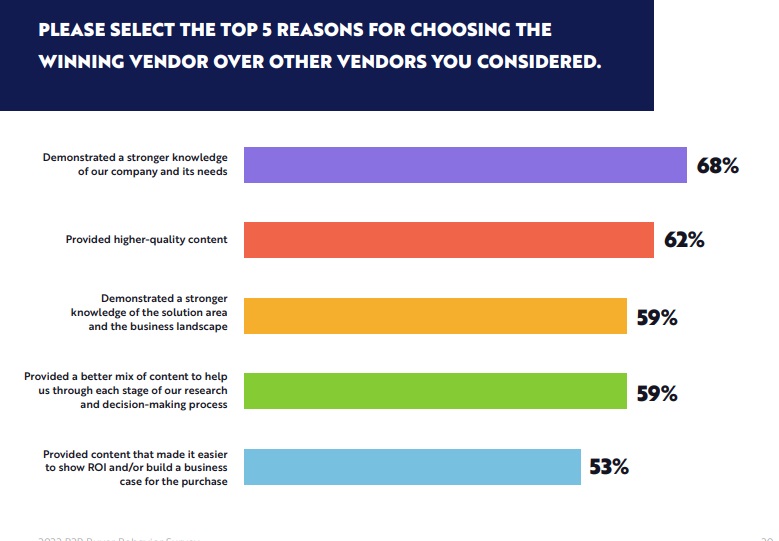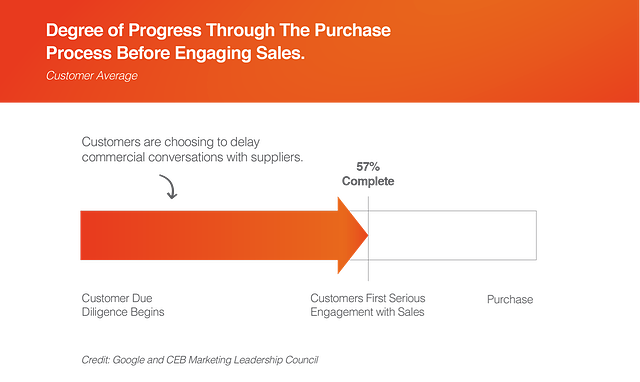9 Keys to Crafting a Powerful Sales Pitch

The sales world has changed. If you’ve been in sales for a long time, you’ve seen it for yourself. And if you’re new to the game, you’ve probably heard a seasoned colleague talk about “the old days” when reps were in control of the sales pitch.
The internet and the rise of channels like social media and content marketing have flipped those old days on their head. Customers are now more informed than ever, even before they reach out to your sales team.
A sales pitch is no longer all about the product and the seller—or even mostly about them. Today, it’s all about the customer and aligning what you offer with what they need.
In this article, we’ll take a deeper dive into the art of the sales pitch, including 9 ways to design one that resonates with your ideal buyer.
Quick Takeaways
- B2B buyers choose vendors who show the best knowledge of their company and needs.
- Before you build your sales pitch, research your customer and their pain points.
- Emphasize value over features. Focus on the specific benefits you can deliver for a buyer.
- Create a compelling sales deck and customize it to each buyer you pitch to.
- Don’t be afraid to mention competitors and differentiate your brand. Tell client success stories to support the promises made in your pitch.
- Make your sales pitch conversational—even the hard sell portion of it.
- Know how to accept a “no” gracefully. It could win you more deals in the future (maybe even the one you just lost).
What’s In a Sales Pitch?
We know that customers have all the product and vendor information they need right at their fingertips. But what does it really mean for your sales pitch in practice?
In short, it means you need to flip your perspective. Your sales pitch, odd as it may sound, is no longer all about what you’re selling. Instead, it’s about how your solutions align with a potential buyer’s needs, and how well you demonstrate the value you can deliver as a result.
Those answers won’t be the same for every customer—which means your sales pitch can’t be, either. It’s critical to customize your pitch each time you give it, not only for the buyer company but also the specific decision makers you’re pitching to.
Nearly 70% of B2B decision makers say this type of company-specific knowledge is the reason they chose their current vendor over other alternatives. In other words: proving in your sales pitch that you understand your buyer better than your competitors is what will make or break your ability to win the deal.

But, alas, this doesn’t mean you can’t talk about your product or hard sell at all—you can, and you should. Let’s look at 11 keys to crafting a sales pitch that strikes the right balance between customer-centricity and old-school sales pitch firepower.
9 Keys to Crafting a Powerful Sales Pitch
Know Your Customer
First thing’s first—you’ve got to do your research before you pitch to a customer. Even if you know them already from sales conversations past, do a deeper dive before your sales pitch. Be sure you’re equipped with all the information you need to show why your solutions best fit their needs.
This means:
- Reading up on the company’s mission and history
- Checking for recent news about them
- Learning who their key decision makers are
- Reviewing past sales interactions
- Thinking critically about how your solutions can help
Emphasize Pain Points
Pain points are the problems or gaps that drive customers to seek out a solution—and in a sales pitch, they’re the biggest motivators for buyers to take purchase action. Pain points remind buyers why they are seeking a solution in the first place, and showing that you understand them proves you’re the best option to provide it.
Strategyzer’s Value Proposition Canvas is a helpful template for outlining how your company’s products and services align with pain points for each of your customer segments, and it can be used to clarify the same for individual buyers right before a sales pitch.
Focus on Value, Not Features
Once you know your customer and their pain points, you have all the information you need to effectively highlight value. Value in this context refers to the benefits and business ROI a buyer will experience when they purchase your solutions.
It’s essential to emphasize value during your sales pitch, especially as the main framework when you talk about features. For example: Don’t list just list all the cool new capabilities your software platform offers. Instead, talk about ways your buyer can use those capabilities to reach their unique goals and/or fulfill their specific needs.
This is why the initial research you do in the first two steps is so important. If you’ve done your homework and you know your own offerings, highlighting value should be fairly simple.
Don’t Shy Away from Competitors
It used to be that companies could gloss over or even ignore competitors in their sales pitch because there was a chance that buyers didn’t know about them—or at least not enough to be actively comparing your solutions.
Those days are gone. By the time a prospect gets in touch with your sales team, you can assume they’ve already done their research and know about all of the top options. In fact, B2B buyers do more than half of their research before ever talking to a sales team directly, and they consider several vendors for every purchase they make.

That means you’ve got to address differentiation head-on. While you don’t want to spend too much time talking about the competition, you should highlight the clear reasons why you’re the better alternative, and be prepared to answer questions about competitors if they come up.
Have a Great Sales Deck
There’s a reason sales professionals spend so much time talking about the sales pitch deck. Not only is it an important part of your pitch presentation, it’s often a resource that your buyer goes back to once it’s over to help them make a decision.
Your sales deck should be compelling, well-designed, professionally branded, and chock-full of convincing reasons your buyers should choose you. Use visualizations, product photos and videos, and client testimonials to drive your points home.
But remember: Your deck is meant to complement your full pitch. Don’t clutter it by trying to include every piece of information. Keep it to the most important points, and present them in a clean, concise way.
Pro tip: Make your sales deck a frequently-updated sales enablement resource and train your reps on how to use it effectively.
Make it Conversational
A sales pitch isn’t like a business presentation you give to your boss or your board—it’s got to be conversational and authentic.
Warm your buyer up with some friendly small talk before you start, and keep your sales pitch conversational throughout. You can do this by encouraging your buyer to ask questions as they think of them (rather than saving them for formal Q&A at the end) and building in natural pauses when you can make sure you’re on the same page.
Include Customer Success Stories
There’s nothing that convinces a buyer you’re the real deal more than customer success stories.
By telling real stories of customers you’ve already helped succeed, you add real-world support for the promises you make in your sales pitch.
To make the stories you include in your pitch most effectively, select stories for each pitch that will resonate most with your prospect—ones from clients with similar problems, or who operate in similar industries, and the like.
Navigate the “Hard Sell” Carefully
To convert the deal, you usually need to make a hard sell. But like the rest of your sales pitch, the hard sell has to happen differently than it did in the past. Buyers no longer want to be “sold” to—they want to have real conversations, and get the information they need to make the right decision for their company.
The key here is never to talk at your prospect when you’re making a hard sell—AKA reading a script listing all your best features and telling a buyer why they should choose you.
Instead, stay customer-focused. Trust in your pitch and don’t overdo it. Reiterate the genuine reasons why your solution can be valuable to them, and goals they can achieve as a result.
Handle a “No” with Grace
Last but not least, know how to handle a “no” gracefully. After the time and effort you’ve put in talking to a potential customer and creating a great sales pitch, it’s never fun to be rejected. But it’s part of the job. Handling “no” the right way preserves your reputation and can even win you the deal later on.
When a buyer tells you they’re going in another direction, keep the relationship intact with a polite response. See if you can get a smaller yes by getting them to stay subscribed to your email list or stay engaged in a similar way. Reflect on the experience and what you can learn from it.
You never know—you may hear from that buyer again sooner than you think! And if not, you can use the experience as a way to get better in the future.
How RevBoss Can Help
No sales pitch can be successful if you’re not giving it to the right prospects. If you feel like your pitch isn’t quite garnering the results you expected, take a step back and analyze if you’re going after the right target audiences for your business.
At RevBoss, we’re pros at targeted, account-based sales prospecting and we can help you level up your strategy to earn better results. Our outbound email software and lead generation services are built for startups, consultancies, marketing agencies, and other B2B organizations.
Schedule a quick call with us to learn more about how we can help you grow your business.
